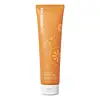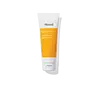What's inside
What's inside
 Key Ingredients
Key Ingredients

 Benefits
Benefits

 Concerns
Concerns

 Ingredients Side-by-side
Ingredients Side-by-side

Water
Skin ConditioningSodium Cocoyl Isethionate
CleansingSodium Cocoamphoacetate
CleansingCocamidopropyl Hydroxysultaine
CleansingSodium Chloride
MaskingAcrylates/Beheneth-25 Methacrylate Copolymer
Phenoxyethanol
PreservativeCitrus Aurantium Dulcis Oil
MaskingGlycol Distearate
EmollientGluconolactone
Skin ConditioningPropanediol
SolventGlycerin
Humectant1,2-Hexanediol
Skin ConditioningCitrus Aurantium Dulcis Peel Oil
MaskingSodium Benzoate
MaskingCitrus Aurantium Dulcis Fruit Water
MaskingCI 77891
Cosmetic ColorantCitrus Sinensis Fruit Extract
AntioxidantTriethyl Citrate
MaskingCaprylhydroxamic Acid
Citrus Aurantium Dulcis Fruit Extract
MaskingCitrus Limon Fruit Extract
MaskingHippophae Rhamnoides Kernel Extract
MaskingLycium Barbarum Fruit Extract
AstringentRosa Canina Fruit Extract
AstringentCalcium Gluconate
HumectantHelianthus Annuus Seed Oil
EmollientLeuconostoc/Radish Root Ferment Filtrate
AntimicrobialSodium Hydroxide
BufferingCI 15985
Cosmetic ColorantCitric Acid
BufferingPotassium Sorbate
PreservativeXanthan Gum
EmulsifyingSodium Citrate
BufferingLimonene
PerfumingLinalool
PerfumingWater, Sodium Cocoyl Isethionate, Sodium Cocoamphoacetate, Cocamidopropyl Hydroxysultaine, Sodium Chloride, Acrylates/Beheneth-25 Methacrylate Copolymer, Phenoxyethanol, Citrus Aurantium Dulcis Oil, Glycol Distearate, Gluconolactone, Propanediol, Glycerin, 1,2-Hexanediol, Citrus Aurantium Dulcis Peel Oil, Sodium Benzoate, Citrus Aurantium Dulcis Fruit Water, CI 77891, Citrus Sinensis Fruit Extract, Triethyl Citrate, Caprylhydroxamic Acid, Citrus Aurantium Dulcis Fruit Extract, Citrus Limon Fruit Extract, Hippophae Rhamnoides Kernel Extract, Lycium Barbarum Fruit Extract, Rosa Canina Fruit Extract, Calcium Gluconate, Helianthus Annuus Seed Oil, Leuconostoc/Radish Root Ferment Filtrate, Sodium Hydroxide, CI 15985, Citric Acid, Potassium Sorbate, Xanthan Gum, Sodium Citrate, Limonene, Linalool
Water
Skin ConditioningCocamidopropyl Betaine
CleansingDisodium Laureth Sulfosuccinate
CleansingGlycerin
HumectantPanthenol
Skin ConditioningAcrylates/C10-30 Alkyl Acrylate Crosspolymer
Emulsion StabilisingPropanediol
SolventPolysorbate 20
EmulsifyingTocopheryl Acetate
AntioxidantRice Amino Acids
Skin ConditioningAllantoin
Skin ConditioningAscorbic Acid
AntioxidantCellulose
AbsorbentSodium PCA
HumectantLactose
HumectantUrea
BufferingYeast Amino Acids
HumectantTrehalose
HumectantInositol
HumectantTaurine
BufferingBetaine
HumectantHydroxypropyl Methylcellulose
Emulsion StabilisingTetrasodium Glutamate Diacetate
Sodium Hydroxide
BufferingCitric Acid
BufferingLeuconostoc/Radish Root Ferment Filtrate
AntimicrobialCaprylyl Glycol
EmollientChlorphenesin
AntimicrobialPhenoxyethanol
PreservativeSodium Benzoate
MaskingLimonene
PerfumingParfum
MaskingCI 77492
Cosmetic ColorantWater, Cocamidopropyl Betaine, Disodium Laureth Sulfosuccinate, Glycerin, Panthenol, Acrylates/C10-30 Alkyl Acrylate Crosspolymer, Propanediol, Polysorbate 20, Tocopheryl Acetate, Rice Amino Acids, Allantoin, Ascorbic Acid, Cellulose, Sodium PCA, Lactose, Urea, Yeast Amino Acids, Trehalose, Inositol, Taurine, Betaine, Hydroxypropyl Methylcellulose, Tetrasodium Glutamate Diacetate, Sodium Hydroxide, Citric Acid, Leuconostoc/Radish Root Ferment Filtrate, Caprylyl Glycol, Chlorphenesin, Phenoxyethanol, Sodium Benzoate, Limonene, Parfum, CI 77492
 Reviews
Reviews

Ingredients Explained
These ingredients are found in both products.
Ingredients higher up in an ingredient list are typically present in a larger amount.
Citric Acid is an alpha hydroxy acid (AHA) naturally found in citrus fruits like oranges, lemons, and limes.
Like other AHAs, citric acid can exfoliate skin by breaking down the bonds that hold dead skin cells together. This helps reveal smoother and brighter skin underneath.
However, this exfoliating effect only happens at high concentrations (20%) which can be hard to find in cosmetic products.
Due to this, citric acid is usually included in small amounts as a pH adjuster. This helps keep products slightly more acidic and compatible with skin's natural pH.
In skincare formulas, citric acid can:
While it can provide some skin benefits, research shows lactic acid and glycolic acid are generally more effective and less irritating exfoliants.
Most citric acid used in skincare today is made by fermenting sugars (usually from molasses). This synthetic version is identical to the natural citrus form but easier to stabilize and use in formulations.
Read more about some other popular AHA's here:
Learn more about Citric AcidGlycerin is already naturally found in your skin. It helps moisturize and protect your skin.
A study from 2016 found glycerin to be more effective as a humectant than AHAs and hyaluronic acid.
As a humectant, it helps the skin stay hydrated by pulling moisture to your skin. The low molecular weight of glycerin allows it to pull moisture into the deeper layers of your skin.
Hydrated skin improves your skin barrier; Your skin barrier helps protect against irritants and bacteria.
Glycerin has also been found to have antimicrobial and antiviral properties. Due to these properties, glycerin is often used in wound and burn treatments.
In cosmetics, glycerin is usually derived from plants such as soybean or palm. However, it can also be sourced from animals, such as tallow or animal fat.
This ingredient is organic, colorless, odorless, and non-toxic.
Glycerin is the name for this ingredient in American English. British English uses Glycerol/Glycerine.
Learn more about GlycerinLeuconostoc/Radish Root Ferment Filtrate is a natural preservative. It comes from fermenting radish roots with a bacteria called leuconostoc.
Leuconostoc comes from lactic acid.
This ingredient has antimicrobial properties and helps prevent the growth of bacteria in a product.
Leuconostoc is used to make the traditional Korean side-dish, kimchi. It is also used to make sourdough bread (both incredibly yummy foods).
Learn more about Leuconostoc/Radish Root Ferment FiltrateLimonene is a fragrance that adds scent and taste to a formulation.
It's found in the peel oil of citrus fruits and other plants such as lavender and eucalyptus. The scent of limonene is generally described as "sweet citrus".
Limonene acts as an antioxidant, meaning it helps neutralize free radicals.
When exposed to air, oxidized limonene may sensitize the skin. Because of this, limonene is often avoided by people with sensitive skin.
The term 'fragrance' is not regulated in many countries. In many cases, it is up to the brand to define this term. For instance, many brands choose to label themselves as "fragrance-free" because they are not using synthetic fragrances. However, their products may still contain ingredients such as essential oils that are considered a fragrance.
Learn more about LimonenePhenoxyethanol is a preservative that has germicide, antimicrobial, and aromatic properties. Studies show that phenoxyethanol can prevent microbial growth. By itself, it has a scent that is similar to that of a rose.
It's often used in formulations along with Caprylyl Glycol to preserve the shelf life of products.
Propanediol is an all-star ingredient. It softens, hydrates, and smooths the skin.
It’s often used to:
Propanediol is not likely to cause sensitivity and considered safe to use. It is derived from corn or petroleum with a clear color and no scent.
Learn more about PropanediolSodium Benzoate is a preservative. It's used in both cosmetic and food products to inhibit the growth of mold and bacteria. It is typically produced synthetically.
Both the US FDA and EU Health Committee have approved the use of sodium benzoate. In the US, levels of 0.1% (of the total product) are allowed.
Sodium benzoate works as a preservative by inhibiting the growth of bacteria inside of cells. It prevents the cell from fermenting a type of sugar using an enzyme called phosphofructokinase.
It is the salt of benzoic acid. Foods containing sodium benzoate include soda, salad dressings, condiments, fruit juices, wines, and snack foods.
Studies for using ascorbic acid and sodium benzoate in cosmetics are lacking, especially in skincare routines with multiple steps.
We always recommend speaking with a professional, such as a dermatologist, if you have any concerns.
Learn more about Sodium BenzoateSodium Hydroxide is also known as lye or caustic soda. It is used to adjust the pH of products; many ingredients require a specific pH to be effective.
In small amounts, sodium hydroxide is considered safe to use. However, large amounts may cause chemical burns due to its high alkaline.
Your skin has a natural pH and acid mantle. This acid mantle helps prevent harmful bacteria from breaking through. The acid mantle also helps keep your skin hydrated.
"Alkaline" refers to a high pH level. A low pH level would be considered acidic.
Learn more about Sodium HydroxideWater. It's the most common cosmetic ingredient of all. You'll usually see it at the top of ingredient lists, meaning that it makes up the largest part of the product.
So why is it so popular? Water most often acts as a solvent - this means that it helps dissolve other ingredients into the formulation.
You'll also recognize water as that liquid we all need to stay alive. If you see this, drink a glass of water. Stay hydrated!
Learn more about Water